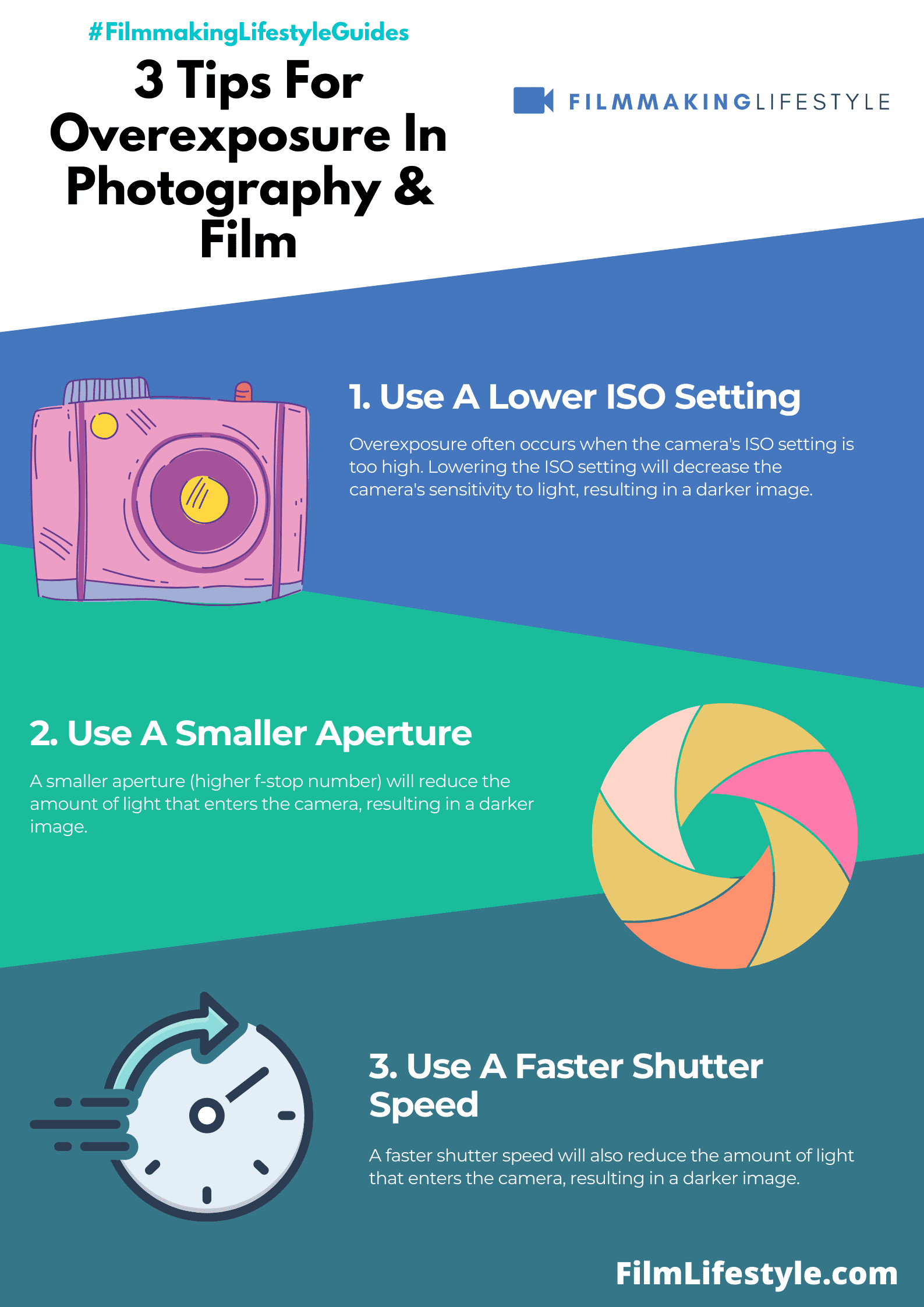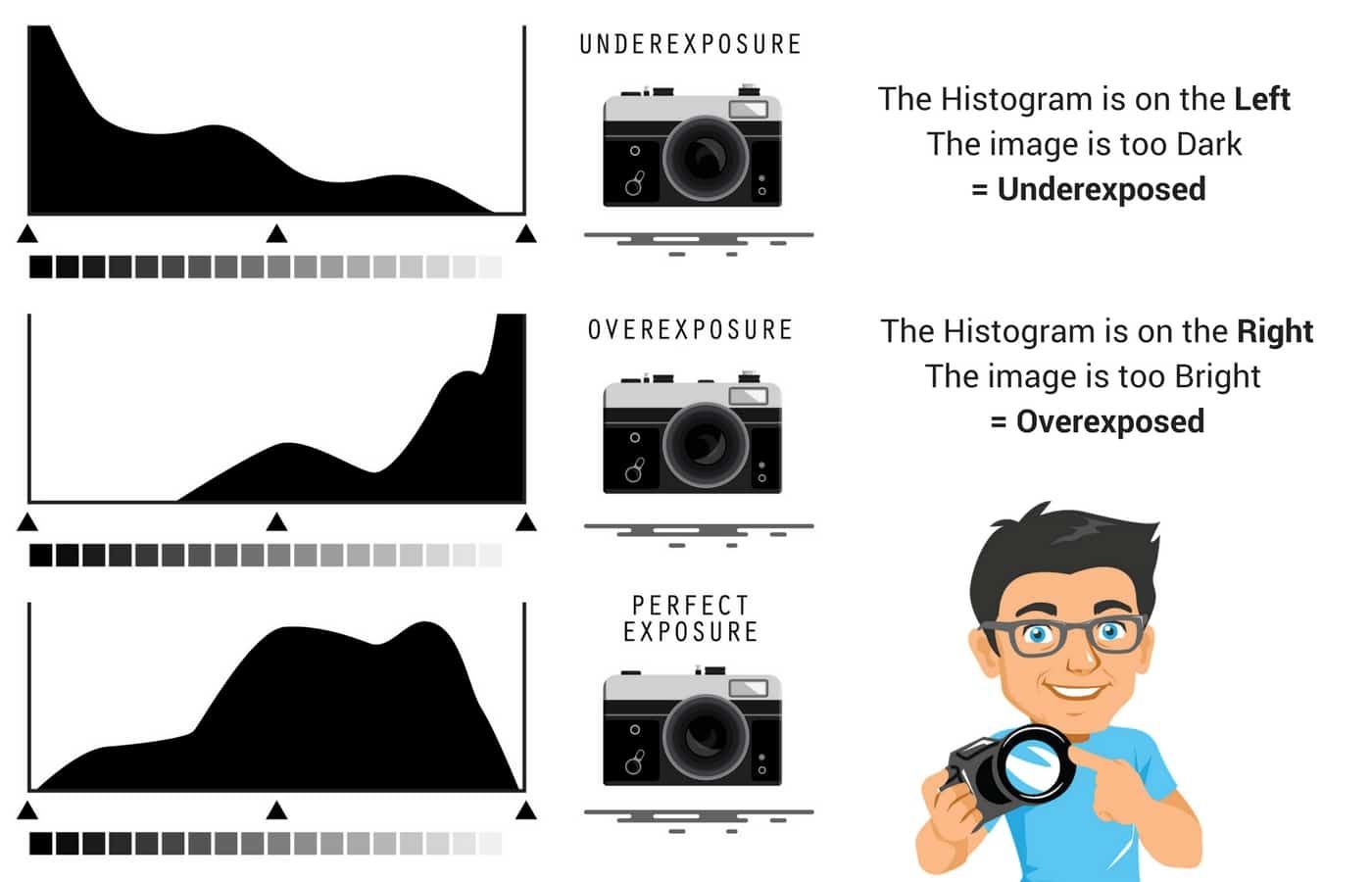Overexposed images are often interpreted as happy or bright because they lack detail which makes them appear more saturated.
In contrast, underexposed photos can have a lot of detail but are usually dark and unappealing to the eye.
This is important because we want our photographs to accurately represent what we see so that it captures the mood we’re trying to convey.
OVEREXPOSURE
What Is Overexposure?
The word overexposure is a term that describes the act of exposing the film to too much light.
The result is that dark areas will become lighter and light areas will become darker, ruining most of your image.
In the world of photography and cinematography, overexposure is a term we often hear, but what’s behind this seemingly simple concept?
It’s when an image captures too much light, washing out colors and details, leading to a loss of quality.
We’ll jump into the nuances of overexposure, exploring how it happens, its effects, and when it might actually be a creative choice rather than a mistake.
Stick with us as we shed light on the balance between luminosity and detail that can make or break your visual masterpiece.
What Is Overexposure
When we capture too much light in our shots, we’re dealing with overexposure.
This technical misstep can occur in both photography and filmmaking, often due to miscalculations in camera settings or challenging lighting conditions.
Understanding overexposure requires familiarity with camera exposure controls.
The triumvirate of shutter speed, ISO, and aperture governs how much light reaches the camera sensor or film stock.
Here are the core aspects where overexposure may slip in:
- Shutter speed – A shutter open for too long allows excessive light, causing overexposure.
- Aperture – A wider aperture leads to a greater amount of light entering the camera.
- ISO settings – High ISO values amplify the sensor’s sensitivity to light, increasing the potential for an overexposed image.
Certain scenes demand precise exposure adjustments.
Bright environments with reflective surfaces can easily trick our cameras into capturing more light than necessary.
In the realm of filmmaking, we might opt for a deliberate overexposure to create a specific aesthetic.
Consider the bleached-out vistas in Mad Max: Fury Road.
Here, overexposure enhances the harsh, dystopian landscape.
To reign in overexposure, we rely on histograms and waveform monitors.
These tools provide visual representations of our image’s brightness levels, allowing us to dial in the right exposure.
Dialed-in exposure is crucial for retaining image quality.
Overexposed shots often result in a loss of detail in the highlights which can’t be recovered in post-production.
Causes Of Overexposure
Understanding what leads to an overexposed shot is crucial for us filmmakers.
It helps in avoiding technical missteps and achieving the intended visual narrative.
Overexposure transpires when too much light hits the camera sensor, creating a brighter image than desired.
Incorrect Camera Settings
One of the main culprits is our camera settings.
If not adjusted properly, they can let in more light than necessary.
It’s vital for us to know how the interplay of:
- Shutter speed,
- Aperture,
- ISO.
affects the overall exposure of our footage.
Misreading Light Conditions
Sometimes, even with the right settings, we’re thrown off by the environment we’re shooting in.
Exterior locations, particularly on sunny days, can be challenging.
We must keep an eye on changing light conditions and adjust our camera settings accordingly.
Equipment Limitations
At times, it’s not just about settings or external conditions but also the limitations of the camera itself.
Lower-end cameras might not handle high dynamic ranges well.
This limitation often results in loss of detail in highlights or shadows.
By understanding these causes of overexposure, we can better prepare and prevent losing detail in crucial shots.
Regular checks on histograms and waveform monitors during filming can guide us to tweak settings and capture the scene just as we envision it.
Effects Of Overexposure
Overexposure can have a diverse range of impacts on a film’s visual storytelling.
Scenes that are overexposed lose their depth, and the texture becomes washed out.
This makes it hard for viewers to connect emotionally with the characters and setting.
It can also signify a certain atmosphere or emotion within a scene if used deliberately.
Let’s consider high-key lighting in Schindler’s List – this technique intentionally overexposes to amplify the dramatic effect.
But, accidental overexposure risks:
- Loss of detail in highlights,
- Distracting viewers from the narrative,
- Miscommunication of the film’s tone.
It’s important to recognize that overexposure isn’t just problematic for the image itself.
It can create issues in post-production because color grading overexposed footage is challenging.
The lack of information in the whites means that reclaiming detail is often impossible.
Filmmakers rely on various tools to prevent or adjust overexposure.
Historically, using ND filters has been a go-to method, as these reduce the incoming light without affecting the color balance.
Cameras with high dynamic range also offer more leeway in exposure settings.
Understanding how overexposure affects both the technical and aesthetic aspects of filmmaking is essential.
It’s a tool that can either be an error or an intentional creative choice.
In mastering exposure, we as filmmakers gain control over the visual language that communicates our stories to the audience.
How To Avoid Overexposure
Ensuring that our cinematic visuals are perfectly exposed is a key skill that we place considerable emphasis on.
Overexposure not only detracts from the scene’s realism but can also flatten our intended dramatic impact.
By essentially mastering camera settings, we gain significant control over image brightness.
We always recommend setting the camera’s ISO at the lowest possible value that ambient lighting permits.
This minimizes the risk of excessive brightness infiltrating our shots.
Utilizing the zebras feature on our cameras allows us to easily identify areas within the frame that are approaching overexposure.
Stripes appear on the parts of the image that are exposed to a certain level, prompting us to make necessary adjustments on the spot.
We can’t overlook the importance of regularly checking our histogram – this tool graphs the tones in our scene and is our guide to achieving balanced exposure.
A skew to the right indicates potential overexposure, alerting us to dial back the light hitting the sensor.
Here’s a succinct list of strategies that further ensure we avoid overexposure:
- Employ ND filters to reduce light entering the lens without altering camera settings,
- Carry out high dynamic range (HDR) cameras for greater leeway in bright conditions,
- Practice in various lighting scenarios to understand how overexposure can manifest.
Harnessing the power of aperture settings is another vital practice.
Opening the iris wider increases light intake, so we often decide to step down the aperture when filming in brightly lit environments.
Waveform monitors serve as an advanced tool in our arsenal.
They provide a detailed representation of brightness across our image, which assists us in making precision exposure adjustments.
By aligning these techniques with our expertise in composition and storytelling, we ensure that overexposure doesn’t compromise our creative vision.
After all, each frame we capture should convey emotion and narrative, achieved through a meticulous balance of technical know-how and artistic flair.
Creative Uses Of Overexposure
While overexposure is typically seen as a misstep in the world of filmmaking, there are scenarios where this supposed flaw is transformed into an expressive tool.
In these instances, filmmakers deliberately harness overexposure to evoke specific emotions or highlight a particular narrative element.

For instance, overexposure can convey a sense of ethereality or otherworldliness.
This technique is often used to reflect a character’s internal state, such as confusion, memory loss, or enlightenment.
A classic example is found in Eternal Sunshine of the Spotless Mind, where overexposure blurs the lines between the protagonist’s memories and reality.
Another powerful application of overexposure is to depict flashbacks or dream sequences.
By washing out details, directors create a distinct visual separation from the main storyline, guiding viewers through a character’s past experiences or inner thoughts.
Saving Private Ryan employs overexposure to represent the intensity and disorientation of war.
Overexposure can also be utilized to represent thematic contrasts within a story:
- To differentiate between past and present,
- To signify purity or innocence,
- To imply a sense of heat or desertion.
also, by overexposing certain shots, filmmakers highlight the impermanence and fragility of moments, such as in scenes of fleeting happiness or foreboding premonitions.
The ephemeral nature of such scenes resonates more profoundly with audiences due to the visually overwhelming brightness.
In the realm of dark comedies or horror, overexposure serves to unsettle the audience.
It’s a stark, visual contrast to the typical shadows and darkness associated with these genres, So amplifying the underlying unease or surrealism.
A Clockwork Orange effectively uses this to challenge viewers’ perceptions of violence and morality.
Understanding how and when to employ overexposure enables us to break the conventional rules of cinematography.
It affords an opportunity to deepen the storytelling process by aligning the visual style with the narrative’s emotional and thematic undercurrents.
What Is Overexposure – Wrap Up
We’ve explored the nuances of overexposure, from its pitfalls to its potential as an artistic device.
By mastering the technical aspects and harnessing the expressive power of light, we can transform what’s often seen as a mistake into a compelling element of visual storytelling.
Whether we’re aiming for technical precision or creative flair, our understanding of overexposure is now a tool that enhances our work, enabling us to convey deeper meanings and evoke stronger emotions through our imagery.
Let’s embrace the light, in all its intensity and subtlety, as we continue to craft stories that resonate and captivate.

Frequently Asked Questions
How Can I Avoid Overexposure In Photography?
To avoid overexposure, regularly check your camera’s histogram, use Neutral Density (ND) filters to manage light intake, and consider shooting with High Dynamic Range (HDR) cameras.
Adjusting aperture settings can also be crucial in controlling the amount of light reaching the sensor.
What Is The Importance Of The Histogram In Preventing Overexposure?
The histogram is a graphical representation of the tonal values of your image.
By checking it, you can ensure that you aren’t losing detail in the bright areas of your photo, thus preventing overexposure.
What Are Nd Filters And Why Are They Useful?
ND filters are Neutral Density filters that reduce the intensity of all wavelengths or colors of light equally.
They are useful in photography for allowing longer exposure times or wider apertures in bright conditions to achieve desired creative effects without overexposing the image.
When Can Overexposure Be Used Intentionally In Filmmaking?
Overexposure can be used intentionally in filmmaking to evoke emotions, depict flashbacks or dream sequences, represent thematic contrasts, or highlight the impermanence of moments.
It’s a creative choice that can add depth to the visual narrative.
How Does Aperture Control Help With Exposure?
Adjusting the aperture controls the size of the lens opening, affecting depth of field and the amount of light hitting the sensor.
A smaller aperture (higher f-stop number) lets in less light, reducing the risk of overexposure.
What Is A Waveform Monitor And How Is It Used In Cinematography?
A waveform monitor is a tool used in video and film to objectively measure the brightness levels of a scene.
It helps cinematographers make precise exposure adjustments to ensure the image is exposed correctly according to their creative intent.
Can Understanding Overexposure Improve Storytelling?
Yes, understanding how and when to employ overexposure can improve storytelling by aligning the visual style with the narrative’s emotional and thematic undercurrents, thus deepening the audience’s engagement with the story.
Matt Crawford
Related posts
2 Comments
Leave a Reply Cancel reply
This site uses Akismet to reduce spam. Learn how your comment data is processed.




great post on overexposure, enlightening (pardon the pun!)
Appreciate the comment